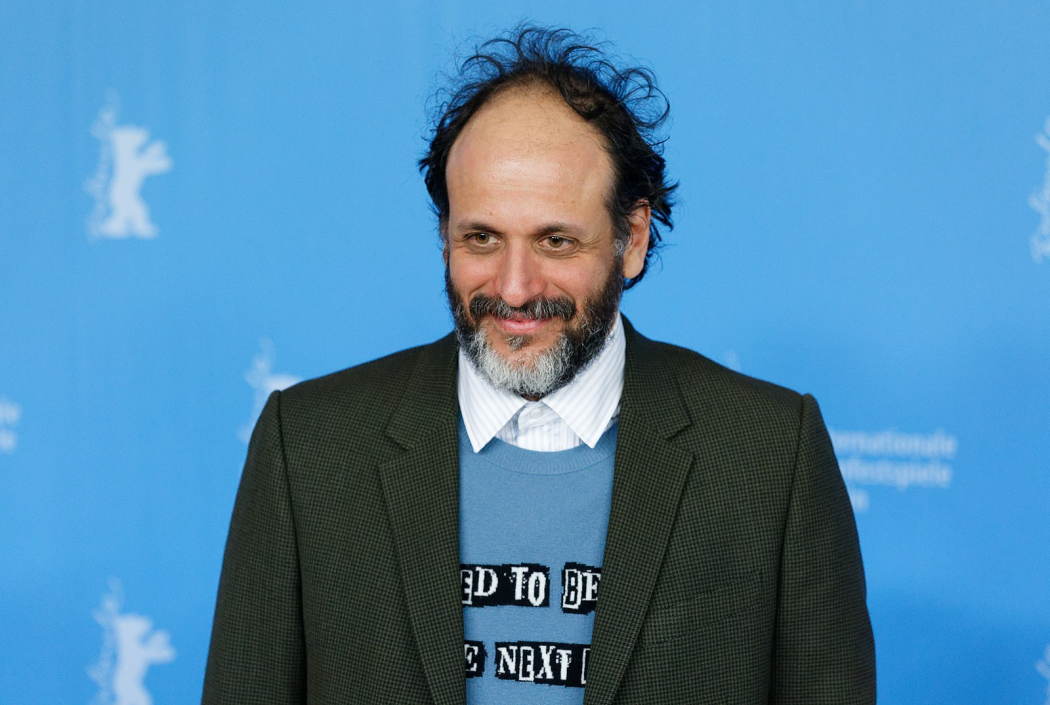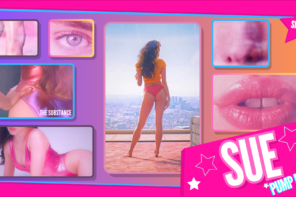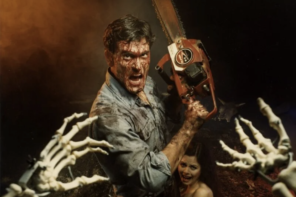The original Suspiria, smelted from sweaty nightmares and candy-coloured shards of glass by the supreme giallo craftsmen Dario Argento, contains a single bad scene: about an hour into the film, our main character Susie Bannion (Jessica Harper) meets up with a stern German psychologist, who gives her a dull, five minute lecture about the coven in the basement of her dance academy and what to do about it. The scene exists, essentially, to be the lone fountain of plot in a film otherwise so gloriously unconcerned with narrative that the score seems more diegetic than the dialogue.
Luca Guadagnino’s remake runs a full hour longer than the original, and he fills that hour with leadership disputes between the members of the coven, gaudy flashbacks of childhood trauma, German political intrigue, no fewer than three Tilda Swinton performances, and old holocaust refugees discovering hidden truths about their past. Goblin’s phantasmic growl has been swapped for the mellow, sickly piano and squirming drums of Thom Yorke. Guadagnino drains Argento’s dayglo rainbow of carnage and leaves only creamy greys and puces. The point couldn’t be clearer: this ain’t your mama’s Suspiria.
In Suspiria, such as in all plotty films, there is the inescapable sensation that the film feels overstuffed and yet, somehow, strangely empty.
Susie Bannion (Dakota Johnson), an American Mennonite girl, has fled her oppressive farmhouse for West Berlin to study at the prestigious Markos Dance Academy, taught by the passionate, enigmatic Ms. Blanc (Tilda Swinton). Susie soon discovers the building’s haxan underbelly, and must choose between protecting the other dancers or giving into Ms. Blanc’s training, and honing a power she didn’t know she had. In addition, there’s a surrounding storyline involving Dr. Josef Klemperer (Swinton again, in grody old man prosthetics) who hovers around the periphery of the plot, trying to solve the coven mystery to absolve himself of lingering guilt. But it’s not much of a mystery, really: a past dancer (Chloe Grace Moretz) informs Dr. Klemperer of the coven in the very first scene, and the film presents coven debate (and even, in an ostentatious long take, coven democracy) in such a nonchalant fashion. What, then, is added by all this plot, beyond mere tedium? In Suspiria, such as in all plotty films, there is the inescapable sensation that the film feels overstuffed and yet, somehow, strangely empty.
Although he made this so soon after Call Me By Your Name – and brought with him Thai virtuoso DP Sayombhu Mukdeeprom – this film contains more DNA from Guadagnino’s previous remake, A Bigger Splash. Many of that film’s elements return: dazzling dance scenes, Dakota Johnson and her whispery line delivery, political backdrops that are opportunistic at best and crass at worst, screenwriter David Kajganich (the weak link in Luca’s entourage), and most of all a fidgety, hyperactive approach to montage and camera movement. Whip pans and snap zooms isolate faces and imbue glances with subjective power, while crane shots often pull away from powerful subjectivity to highlight the architecture of the setting. Jump cuts are sometimes disorienting and rhythmic, but sometimes merely fidgety, not allowing the viewer to disappear into the scene. All this, combined with conspicuously bad slow-motion photography and ostentatious intertitles denoting six (completely nonsensical) “acts” constantly remind the viewer of the artificiality of the film and place it in an uneasy relationship with subjectivity, always teetering on the edge of empathy and cold observation. These metacinematic flourishes are as ostentatious and distancing as the sets and lights in Argento’s original but nowhere near as gorgeous or unified in purpose.
…Suspiria’s most unforgivable act is that it gives us cinema’s only bad Tilda Swinton performance.
Dakota Johnson at least has more to work with here than she has in A Bigger Splash, conveying discovery in empathetic detail, being just coy enough to suggest something brewing under her innocent exterior, but she completely whiffs her (crucial) final scene. Mia Goth and Chloe Grace Moretz both fail to make an impression. In fact, nobody makes an especially deep impression, and I don’t blame any of the actors for this: there is almost no sense of an inner life, a personality, or even a passion for any of the dancers (perhaps because the film was written by a turgid plotty hack). The coven itself, filled up with every veteran character actress in Germany, is much more fun to watch (there are, humourously, just as many old witches on staff at Markos as there are dancers enrolled). Unfortunately (and catastrophically) this is the first Guadagnino film which lacks a great performance, and it’s hard for such a plotty film to function with an absence of character. But Suspiria’s most unforgivable act is that it gives us cinema’s only bad Tilda Swinton performance. She’s fine as Madame Blanc, doing her usual dual ice-queen-mother-figure routine, but her Klemperer is deeply, deadly disengaged, sucking away the pace and interest (what little the film has) whenever she’s on screen.
The Markos building lies just next to the Berlin wall, and its presence is always hovering outside the rainy windows, its untranslated leftist graffiti always partially visible. The film takes place during the German Autumn, and its events, though they never directly intersect with the story, can be glimpsed on televisions and radios. The RAF, a group of armed radical anti fascists (which a past dancer tried to join, and was punished by the coven), were radicalized by the acceptance of old Nazi party members into modern German parliament. Nazis have often co-opted occult symbology to drum up blood-and-soil sentiments (the dance that the Markos girls perform is called Volk, perhaps ironically), but the witch is also a powerful symbol for leftist thought, embodying freedom from material conditions and the legislation of the body. At the heart of Guadagnino’s political stewing is division: of Berlin, of the coven, of Susie’s psyche, and of Germany and, ultimately, The West, between urgent communism and lingering fascism. But there is no synthesis, no ultimate point to the film’s waffling about the intersection of the political and the occult. The politics are ultimately the same as the images: pregnant with signification but empty of meaning.
In modern cinema, Guadagnino is peerless in pure sensual pleasure, which makes his more plotless works – like Call Me By Your Name… – so rewarding, and makes failures like Suspiria all the more infuriating.
… And yet, as much as I want to completely dismiss this film, I can’t, because of three totally beguiling and absorbing dance sequences. First is a scene when Susie performs a famous Markos dance, and another dancer named Olga is locked in an adjacent studio full of mirrors, Susie’s every gesture and thrust contorts Olga’s body in graphic and gruesome shapes; it’s top notch body horror. Second, the performance of Volk, a fantastic ballet of motion, one of the only colourful moments in the film, and one of the only sequences where bodies moving through space acquire visceral immediacy. Third, the climactic scene, which I cannot spoil, but it’s the only moment when Guadagnino’s slow motion, colour-drained cinematography becomes purposeful. What’s more, the quick-cut sensory overload dream sequences are fantastic. When this is just a film about bodies in motion, sensory pleasures, and dance related body horror, it finally gets off the ground. In modern cinema, Guadagnino is peerless in pure sensual pleasure, which makes his more plotless works – like Call Me By Your Name and, to a lesser extent, I Am Love – so rewarding, and makes failures like Suspiria all the more infuriating.
My strong negative response to this film begs the question: would I be so negative about Suspiria if it weren’t a remake of a masterwork? If this same film was just a Luca Guadagnino horror dance picture with no allegiance to Argento, would I have liked it more? Those quandaries are interesting, but I prefer to ponder the more pressing and depressing question: what would a Luca Guadagnino-directed, Thom Yorke-scored dance film, or a Luca Guadagnino body horror film be like, untethered from a dull plot, a dull colour pallette, and a dull socio political thesis? Jean-Luc Godard once said that the best way to criticise a movie was to make another movie. That makes my job a bit easier: the perfect criticism of Guadagnino’s film has already been made, 41 years ago, by a man named Dario Argento.
Suspiria is currently playing at the Cineplex Forum (just by the Atwater metro station) and will arrive at the Cinema Du Parc on Friday, November 9.









What an intense review! You make me feel like I’ve seen the movie. You have an uncanny way of making me feel you’ve written this piece exactly for me. I am totally awed by your knowledge, vocabulary and insight!